Vietnam 2015: Vibrant
Standing at the curb to cross the street in Ho Chi Minh City (HCMC), I saw a swarm of bees coming at me as if their hive had been disturbed, but they were motorbikes with helmeted riders. I had read about this phenomenon, but the reality was still scary, made worse by riders freely using the sidewalk in both directions, and electric bikes sneaking up noiselessly. I had to keep my eyes and ears alert at all times, like walking in a big city with antennae out for muggers. My wariness decreased as I got used to it and noticed that traffic was slow and riders careful to avoid each other and pedestrians. In 15 days of criss-crossing roads in several cities in Vietnam, I saw only one accident, the aftermath of a collision between a bicyclist and scooter, and that was on the last day of my visit.
All countries have monuments and museums dedicated to struggles and wars they have won, but in Vietnam they are unusually prominent. It defeated the French army at Dien Bien Phu to gain independence and fended off 550,000 US troops for a decade. In 1970, Vietnam’s GDP per capita was less than $100 and that of the US $5,000. On top of the resource imbalance, the people of Vietnam are generally small in stature and slight in build. But they have a big heart. Their courage, ingenuity and fortitude more than compensated to tip the balance in their favor. The cost was high, with 3 million killed and countless others injured and lives disrupted, and some still suffering the after-effects of napalm and Agent Orange. Their victories are commemorated in museums in HCMC and Hanoi.
Photographs taken by international journalists shown at the War Remnants Museum in HCMC were especially moving. They should be shown to all commanders-in-chief that are considering going to war, especially those that have not been in one. The Hoa Lo prison, also known as the “Hanoi Hilton”, that housed US prisoners, was actually built by the French to imprison Vietnamese freedom fighters. They were kept in horrible conditions and the guillotine on exhibit was used to decapitate some.
Because the Vietnam War was the defining international drama of my youth, I’ve wanted to visit the country for a long time. My emotions from that period erupted when I visited museums and monuments even though my participation in the anti-war movement was minuscule, just joining demonstrations in London, New York and Washington.
Being a citizen of a newly independent India shaped my political lens. From that perspective, the US invasion of Vietnam looked like an attempt at re-colonization to compensate for France’s defeat. I recall that a vacuous domino theory to prevent the spread of socialism was used to justify the invasion even though the obvious big domino, China, was left out. Instead, the little dominos—Korea and Vietnam—were invaded and left with the suppurating wound of divided countries, like Pakistan and India, that weakened both and impeded development. In the end, it was the limitations of the socialist political and economic system that led to its collapse rather than war.
Historical Influences
Chinese
Vietnam is an old culture that has endured many invasions, all eventually defeated. China’s has been the longest lasting. It has dominated Vietnam on and off since recorded history. The lengthiest period was a thousand years during the first millennium of the Common Era. But it was eventually expelled, as were the Mongols when they ruled China and invaded Vietnam with a force of 500,000, and later the Chinese again in the 15th Century. It’s most recent invasion in 1979 was repulsed in a few weeks.
From China, Vietnam got science and engineering and its script, although that has changed. It also absorbed religion and philosophy by adopting a blend of Confucianism, Taoism and Mahayana Buddhism, which came from India originally, but through China to Vietnam. Indeed, these strains have merged with local animism to form the religion practiced by about 80 percent of the population. The Temple of Literature in Hanoi is dedicated to Confucius. Initially built in 1070 and added to subsequently, it housed the first Vietnamese university and honors scholars. It is now a tourist site with a complex of Vietnamese style pagodas and five courtyards, gardens and a pond. Appropriately, when I visited, a group of students were taking graduation photographs in one of the courtyards.
India
Another significant and durable influence came from far-away India without an invasion. Until the 6 Century CE, an Indianized Khmer people developed the Mekong Delta area by constructing canals for irrigation and transport. Known as the Funan Kingdom, they traded with countries as far as the Mediterranean. They used Sanskrit as a sacred language and the influence of Indian art and architecture is evident. Overlapping in time, from about the 2nd to the 15th Century the Cham or Champa people, of Malay origin, dominated central Vietnam around Da Nang and their suzerainty at times stretched far to the south. They also practiced Hinduism and used Sanskrit and later adopted Buddhism.
Their main port for international trade was modern Hoi An, a UNESCO Heritage Site on the banks of the river Thu Bon, an important tourist destination with an attractive, well-maintained old town. There, a few beautifully designed Chinese Clan houses and a covered Japanese bridge remain, and also a few museums. Sadly, the town is overrun with tourists, detracting from its lazy beauty, but benefiting local commerce greatly as all shops, restaurants and services cater to them. Most tourists strolled through the narrow streets popping into shops or places to eat, but Japanese tourists chose to see the town sitting in out-facing, single-seat cycle rickshaws traveling in convoys of 15-20. At dusk, the town lit up with multi-colored lanterns along the river, over the main bridge and the length of the night market.
The ruins at My Son, the only significant remaining site of the Champa civilization, and also a UNESCO Heritage Site, are a couple of hours drive from Hoi An. For a thousand years from the 4th Century CE, My Son was the religious and intellectual center for Champa rulers. At its zenith, it had a complex of 70 temples. Time took its toll, but the final straw leading to their near total destruction was the US carpet-bombing intended to kill the Viet Cong. Not much is left intact, but decorative sculptures inset in exterior walls or inside the temples suggest its former glory.
Luckily, French archeologists had removed many sculptures and housed them in a colonial building in Da Nang, now the Museum of Cham Sculpture. Some of the sandstone carvings of Laxmi, Ganesha, Vishnu, Garuda and Buddha are exquisite. The History Museums in HCMC and Hanoi also have some equally beautiful pieces.
Nguyens
By the early Nineteenth Century, Nguyen Dynasty had consolidated it hold over Vietnam. They built a citadel in Hue, a city that became famous as the site of the Tet Offensive during the Vietnam War. Much of the citadel was destroyed, but is being rebuilt. After viewing the model and listening to a video near the entrance, walking around the huge enclosed area gave an idea of its splendor, especially sections that remained or have been rebuilt such as the Emperor’s Reading Room, Royal Theater and Thai To Mieu Temple complex. A day’s tour that combined cruising down the Perfume River that flows through Hue and a bus ride took us to several Emperors’ tombs. Tu Duc, the longest reigning monarch, built the most impressive structure that includes temples, a theater, a lake and pavilion.
Europeans
The Portuguese established a trading post in Hoi An in the 16th Century. They introduced Catholicism and the foundation for the Latin-based script used in Vietnam today. About 10 percent of the population is still Catholic and the script was further developed in the 17 th Century and eventually replaced Chinese characters in the 1930s to facilitate the spread of education. The literacy rate in Vietnam is now about 94 percent.
The French became militarily active in Vietnam in the 1850s and made it a protectorate in the 1880s. The Viet Minh eventually defeated them in 1954 to gain independence. I asked two young French ladies traveling through the country what they noticed of French influence. They said “just the buildings”. There are some magnificent colonial structures in every city such as opera houses, museums, churches and the HCMC post office. Many others have been converted into government administrative offices.
Communists
The Viet Minh were dominated by the Communist Party, which formed the government of North Vietnam after independence and, after a long period of war against South Vietnam and the US, a re-unified Vietnam. Ho Chi Minh led this movement until his death in 1969. Considered the Uncle of the Nation, his embalmed body lies in state in an elaborate mausoleum inspired by Lenin’s in Moscow, watched over by a military honor guard. The exterior looks like the Lincoln Memorial in Washington DC, except that it is made of gray granite. Uncle Ho’s residence and a museum nearby are premier tourist destinations in Hanoi. Statues to commemorate him can be seen in every city and government office, a reverence verging on deification.
Vietnam Today
The recent wars have receded for the Vietnamese and relations with France and the US have normalized. The post-war generation is busy looking at their smart phones or listening to music. It is eagerly participating in the country’s thriving “socialist-oriented market economy”, unleashed by reforms adopted in 1986. These policies have spurred economic growth, with the GDP per capita growing from about $100 to $2,000. The private sector now contributes about two-thirds of the economy. The percentage of people living in poverty has dropped from 60 percent in the 1990s to under 10 percent. In the latest PISA international education test, Vietnam came in 17th, much higher than other countries with similar income. It’s dogged resilience and creativity has turned its attention to commercial enterprise and economic development. In my view, they are the most energetic people in South East Asia.
Everyone is an entrepreneur in Vietnam. Cities have shops and stalls actively soliciting customers to sell food and dry goods, and men along streets offer motorcycle pinion rides. Intense activity is most evident in HCMC, still Saigon to locals. It is a big, commercial metropolis with wide roads and tall steel and glass buildings that dwarf the older structures. Despite lower official numbers, locals say that 12 million people live there and drive 6 million motorbikes. It boasts many industrial parks, free trade zones, hi-tech parks, banks and a huge port along the Saigon River. The city contributes about a quarter of Vietnam’s economy. My hotel was in the central district, allowing me to walk to virtually all the tourist sites, museums and many restaurants. The only impediments to getting around were the hot and humid climate and crossing roads.
In contrast, Hoi An was easier to manage as traffic in the old town is restricted. Pedestrians were mostly tourists and shop owners. Except for cycle rickshaws, which were orderly, walking around was safe. My stay in Hue was short, one full day boat trip and, on the next, a long walk along a broad avenue by the river to the citadel and back.
Hanoi was busy, but subdued compared to HCMC. Colonial buildings still dominate the city’s landscape. The area around the Opera, History Museum, and Sofitel’s Metropole Hotel could have been plucked out of Paris. The official buildings were easy to spot. Whether modern or colonial, they are painted a hue of yellow with usually four or five tall flagpoles in front sporting humungous Vietnamese flags, bright red with a blazing yellow star in the center. If the building was wide enough, there were an equal number of red flags with a yellow hammer and sickle in the center.
My hotel was in Hanoi’s old quarter with narrow streets and houses, most with shops or restaurants at street level. Houses in old town and other parts of Hanoi, known as “rocket houses” have narrow fronts, but can be deep and high, because at some stage taxes were based on frontage. It was easy to get lost as streets looked similar. Maps were of little help because street names looked alike and sometimes a name would suddenly change. Dodging and weaving, avoiding motorbikes and people was necessary for survival. I had to make a conscious decision to stop and look into a shop rather than browse as I walked by. Women outside shops would accost me asking “you buy something from me?” Shops kept open late, many owners eating dinner outside with the lights dimmed. Possibly they lived on the premises.
From Hanoi, I took a two-day trip to Halong Bay. A four-hour drive to Cat Ba Town’s docks and then a short boat ride got us to our cruise ship that had about 20 comfortable cabins. We set sail after lunch, passing an endless chain of islands, small hills of different sizes, like uneven stones of a necklace or, as the legend goes, a dragon’s tail flailing in the Gulf of Tonkin. I could imagine how magnificent it would look in better weather, as it was overcast and misty, obscuring the beautiful landscape. We stopped at a village where people live in floating cabins and fatten fish they catch in enclosures before selling them from boats. The next day we visited the Hang Sung Sot caves, three huge well-lit caverns with interesting karst formations, the main attraction a huge phallus-like shape known as the cock-rock. The path through the caves was full of tourists, apparently a throughput of thousands every day. The fleet of cruise ships anchored below was corroborating evidence.
Vietnam is a densely populated country with 90 million inhabitants. About 85 percent are Viets, but there are more than fifty minorities, ethnic Chinese being the largest. Hanoi’s Museum of Ethnology has information, photographs, garments, jewelry and other artifacts of these peoples. The grounds outside have replicas of ethnic homes reflecting their different ways of life. Between them is a pond where I was lucky to see a water puppet show that Vietnam is known for. Minorities generally do not fare well economically with almost 50 percent still living in poverty.
Although important in family life, women do the heavy lifting in Vietnam, literally. In my wandering in Hanoi’s old quarter, I saw only women carrying shoulder baskets (a bamboo pole across the shoulder with a basket at each end to carry goods), some old and small. Much of the backbreaking work in rural areas such as tending to rice paddies is also their task. Despite their heroic contribution during the war, women do not enjoy equal rights. The Women’s museum in Hanoi had objects and photos to show their role in the country’s history. Redress is in progress through education as half the students enrolled in universities are women.
Food & Lodging
A review of Vietnamese food could fill many pages. Food tours, mainly street food, are available in most cities. I took tours in HCMC and Hanoi and followed the suggestions of a tour-guide in Hoi An. Sadly, I did not take to street food much, partly because the only meat I eat is seafood and most of the offerings had chicken, pork or beef. Nevertheless, I enjoyed Bahn Xeo in HCMC, a fried crispy crepe or dosa stuffed with shrimp, bean sprouts and fresh herbs, cut up and wrapped in lettuce and a pan-like leaf, and dipped a light fish sauce; Cau Lau in Hoi An, thick noodles mixed in a rich dark sauce with fried tofu (usually pork); Bahn Khot in Hue, small fried pancakes stuffed with shrimps, Mung beans and spring onions; and Goi Cuon everywhere, fresh greens, carrots, herbs and shrimp wrapped in rice paper as a spring roll with either fish or peanut dipping sauce, spicy only in Hoi An, a sign of lasting Indian influence perhaps.
I fared better with restaurants recommended in the guidebook that were frequented by locals and tourists. Nha Hang Ngon in HCMC had excellent Bahn Xeo, crab soup and lightly fried noodles with vegetables and seafood; Morning Glory in Hoi An had a vegetarian soup with tomatoes, chanterelle-like mushrooms, cubes of tofu in a lime flavored broth with scallions floating on top; Mandarin café in Hue had the best Bahn Khot of my trip; and New Day in Hanoi had a delicious spicy fried fish with rice. Vietnamese beer is light and goes well with the cuisine’s fresh and delicate flavors. Among the brands, 333 and Saigon Special tasted best. I tried Ruou, a rice wine also known as Hanoi Vodka. When chilled it tasted like Sake and paired best with spicy food. Dalat white and red wines were disappointing, however.
Hotels were excellent value with helpful and courteous service. I stayed at the Norfolk in HCMC, Vinh Hung Riverside in Hoi An, Imperial in Hue, Essence Palace in Hanoi and Garden Bay Cruise in Halong Bay. The rooms had modern conveniences and wifi that worked well. They offered sumptuous breakfasts that, unfortunately, I did not partake of, except for good, strong local coffee with sweet condensed milk. Although it’s difficult to choose the best among them, Essence Palace was my favorite for its convenient location in the old quarter and exceptionally helpful concierge service.
Art
Symbolizing the creative vibrancy of the country, art and photography galleries were spread widely, especially near museums. The Fine Arts Museums had modern abstract work, traditional lacquer paintings, and watercolors on silk that showed a flow of softer hues. Understandably, they also housed monumental art depicting the independence and socialist struggles. Statues were displayed in the grounds and courtyards. These museums also had old sculptures of Buddha and Vishnu from the Funan and Champa periods. I browsed through commercial galleries in and around the museum and bought two pieces by young up-and-coming artists, one each in HCMC and Hanoi.
Transport
Getting around in Vietnam was easy. For the longer trips, I took Vietnam Airlines, which had comfortable and on-time flights. Although a little more expensive than other local carriers, I was told it was more reliable because it had priority. I took a “luxury sleeper” bus between Hoi An and Hue that had airplane business class-like bunks, three in a row on two levels—a bit cramped, but comfortable. On that trip, we passed the “marble mountain” near Da Nang with hundreds of marble processing and sculpting workshops along the road, sounding it’s death-knell. The mini-bus ride from Hanoi to Cat Ba Town was long and tedious, passing by huge factories like Foxconn on either side before opening up to fields. Inter-city traffic moved slowly as the road meanders through a continuous chain of small towns and villages. Behind the developed strip along the road were rice paddies or farms growing vegetables. In cities, I mostly walked but tried public buses a couple of times to distant museums and even risked a few motorcycle pinion rides.
Weather
The weather did not cooperate for my two-week visit. In the South it was hot and humid with a few downpours. Central Vietnam was cooler and generally overcast with bursts of rain. In Hanoi, either light clouds or pollution or both created a lingering mist, reminiscent of New Delhi and Beijing, and the sun rarely broke through. Disappointingly, it was cloudy and raining lightly for my entire trip to Halong Bay. These conditions did not help my photographs.



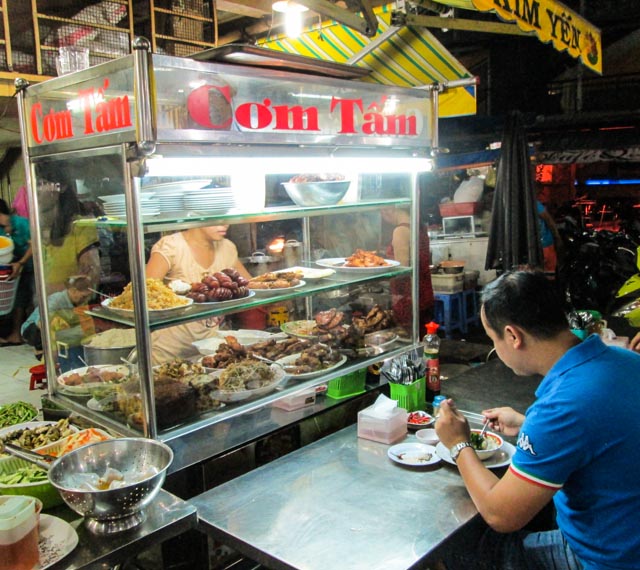
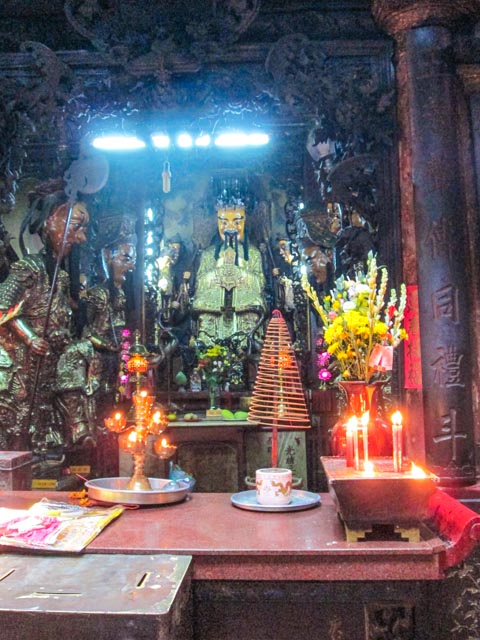

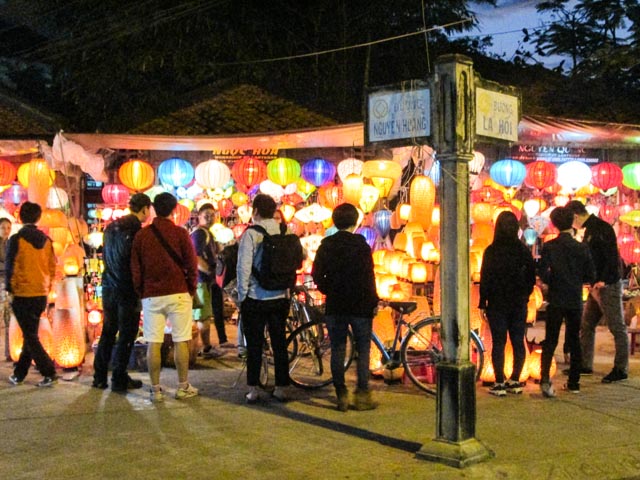
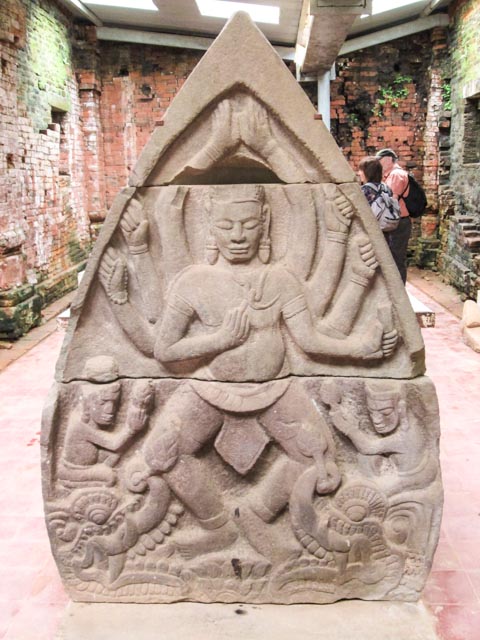
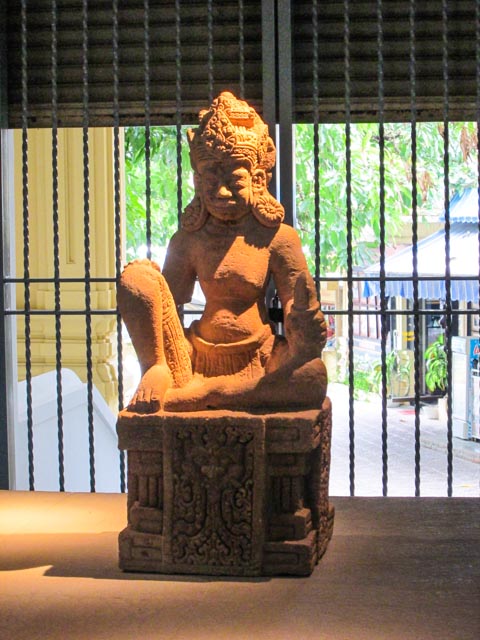

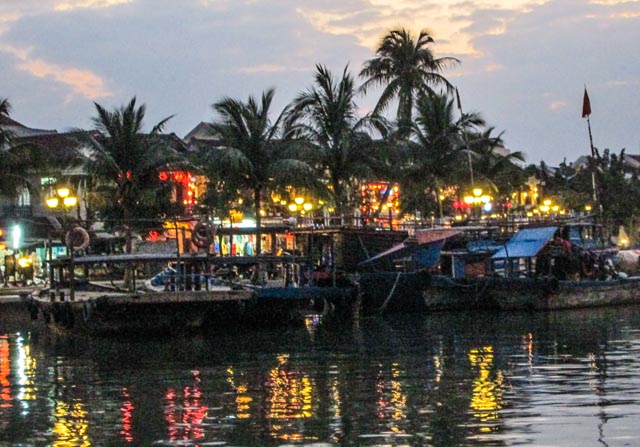

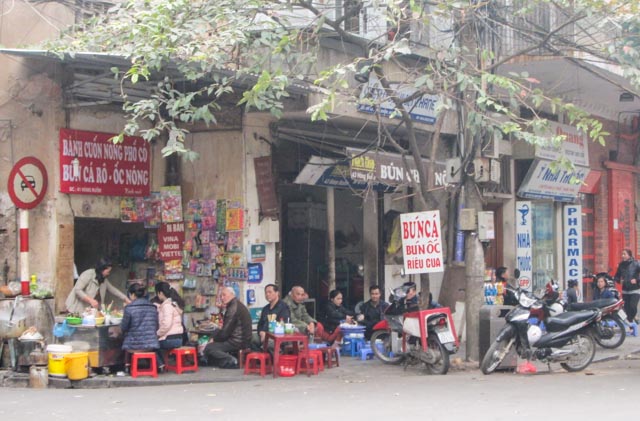





12 Responses to Vietnam 2015: Vibrant